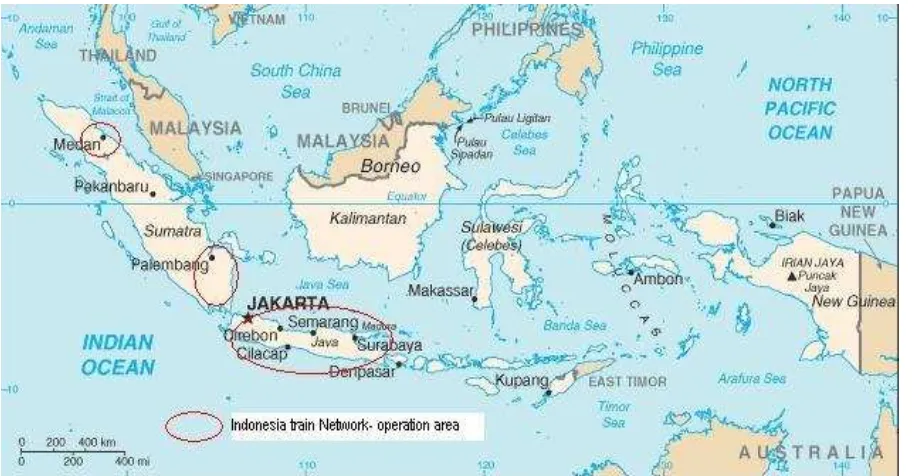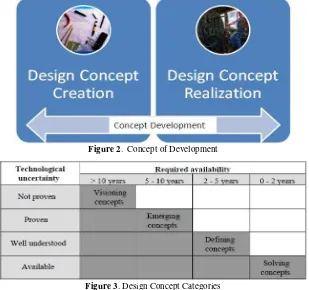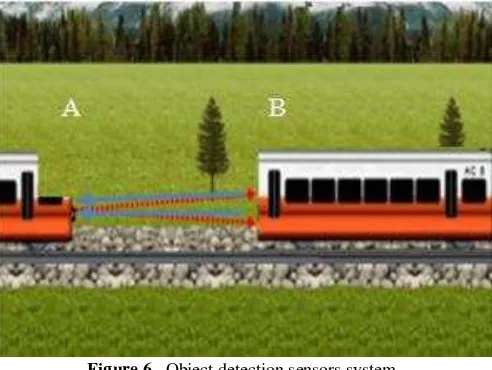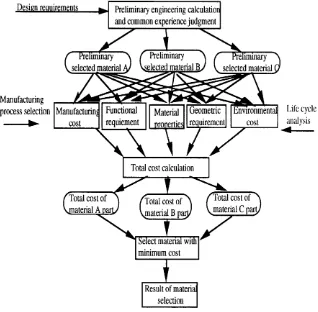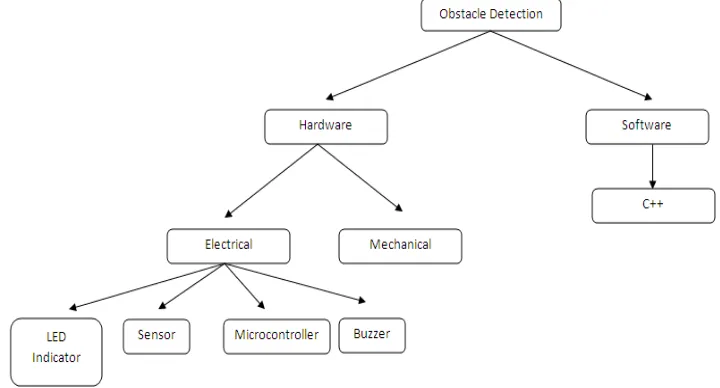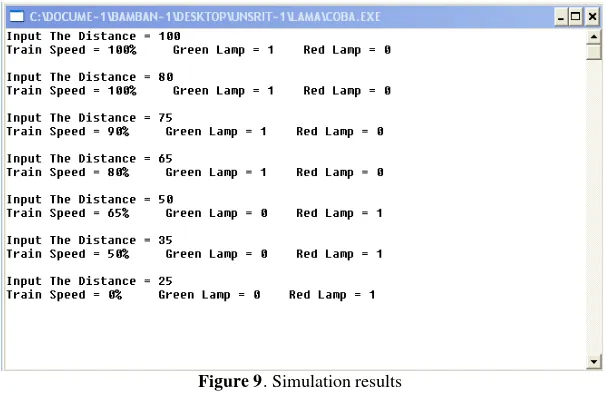453
DESIGN CONCEPT OF TRAIN OBSTACLE DETECTION SYSTEM IN
INDONESIA
Rossi Passarella 1,*, Bambang Tutuko2 & Aditya P.P. Prasetyo1 1
Digital and Microcontroller Lab. Department of Computer Engineering. University of Sriwijaya Jln. Raya Palembang Prabumulih Km 32 Inderalaya OI.30662, Indonesia.
2
Controls and Automation System Lab. Department of Computer Engineering. University of Sriwijaya Jln. Raya Palembang Prabumulih Km 32 Inderalaya OI.30662, Indonesia.
Email: 1passarella.rossi@unsri.ac.id, 2aditrecca@gmail.com , 3bambang_tutuko@unsri.ac.id
ABSTRACT
Based on statistical data in Indonesia train collisions occur each year. The solution to prevent these accidents is to create early warning detection devices for locomotive driver before the collision or accident occurred so that locomotive drivers can avoid them (preventive). The method used is by using infrared system which is placed in front of the locomotive, so when there are objects detected within a range distance, the indicator lights will light up. This light indicator is will be a signal for locomotive driver to make a decision of reducing speed or to stop the train. This study is an early stage of a series of researches which expected to be autonomous system designed, where the locomotive driver make their own decisions base on the input information, eventually it would reduce collisions caused by human error from the locomotive driver.
Keywords: Design concept, Object detection, and Train accident.
1. INTRODUCTION
Transportation sector is a key component of the economy impacting on development [1, 2].The train is a very important means in transportation sector for developing countries such as Indonesian, due to the capability of mass transport for transporting human and goods, as well as to improve the economic growth [3].
The area of greatest population density in Java Island is Jakarta, where the density of 1,005 persons per km2 is approximately 12 times higher than the total density of Java Island. In Java, passenger trains were more important than freight trains. The railway network in Java is connecting the capital city of Jakarta to other major cities like Surabaya and Bandung. This network was built by the Dutch, and some new lines were built after Independence Day.
The train is only operating in two islands with almost 90% single line. The lines are Sumatera and Java as shown in figure 1. The networking from Jakarta to Surabaya was divided into two ways which are north coast and southern line. Another network is Sumatra's networks, which are concentrated on the northern (around Medan) and the southern (Lampung to Palembang) parts of the island. Passenger trains on this island are less frequent than in Java. Train users in two islands are approximately 185 million based on the number of trains’ passenger by November of 2010 [4].
A railway in Indonesia is managed by PT Kereta Api (Persero). With a fairly high number of users, PT. Kereta Api should improve the quality and management to meet consumer rights under Law no. 8 /1999, which is needs to be accommodated in the preparation of the Minimum Service Standards (MSS) trains. One of MSS is the passenger right for comfort, security and safety [5].
454
Figure 1. Indonesia maps which shows the area of train networks
Table 1. Train accident in Indonesia [6]
No Types of accident Years
2004 2005 2006 2007 2008 2009 2010
1 Collision between train versus train 7 10 5 3 3 5 3
2 Collision between train versus vehicle 30 15 24 20 21 21 8
3 Dropped
91 66 68 110 99 41 25
4 Tumble 5 7 8 7 4
Total 128 91 102 140 131 74 40
Table 2. Indonesia train accident victims [6]
No Consequences of accidents
Years
2004 2005 2006 2007 2008 2009 2010
1 Fatalities 85 36 50 34 45 57 60
2 Serious wound 78 85 76 128 78 122 87
3 Minor injuries 29 111 52 164 73 76 102
Total 192 232 178 326 196 255 249
With the total numbers of accident and its consequences, Indonesia train transportation should find a solution to minimalism those numbers. One of the solutions is using a technology such sensors to help locomotive driver in operating the train.
455 2. SYSTEM DESIGN
2.1. Concept Development
The concept developments have two design steps. i.e. design concept creation and design concept realization as shown in figure 2. This paper describes the design concept creation based on solving concepts where the required availability between 0- 2 years as mention in figure 3.
Figure 2. Concept of Development
Figure 3. Design Concept Categories
The flow decision as shows in the figure 4 should be made in concepts development. The initial stage is to develop preliminary studies which are (i) gather data train accident in Indonesia, (ii) how to solve the problem, (iii) selecting the material, (iv) review the product idea and identify the locomotive driver need, (v) problems and future needs. The second stage is to create concept prototype, in this stage the prototype is build to demonstrate how the concept meet the need, and to review the concept and alternative approaches to solve the problem, to make changes prototype and concept summary based on experiment. The third stage is pass gate review, which is the decision to accept or to reject based on the reviewed concept, and experiment.
2.2. The Principle of Operation
The object detection sensor is mounted on the front of the train head (figure5 A) and detects obstacles while moving forward. When the train is shifted into forward, the system is armed. Inside the driver room there are 2 LED display the illuminates (green and red), the green LED indicates that obstacle is not detect although the red LED indicates that an obstacle is within the range of the object detection sensor (figure 5B)
456
(A) (B)
Figure 5. A. The object detection sensor is mounted on the front of the train head B. The LED indicators are placed on the driver room.
The object detection sensor is using the infrared range finder system. The Infrared range finder works by emitted and reflected back (or not reflected at all). The light reflected back at an angle that is dependent on the distance of the reflecting object. The reflected light signal are collected by a lens and focused onto a photodiode inside the sen-sor unit. The reflected light shift phase is compared with the reference signal. From the number of shift phase, a required distance is calculated with good accuracy.
Figure 6. Object detection sensors system.
The illustration on how the infrared range finder is working shown in figure 6. As the system work the distance between point A and B is calculated as:
=
12�
(1)Where: d is distance at point A to B c is speed of light in the atmosphere
t is time for the round-trip between A and B.
However the t value is affected by the delay from light travelling, to find t is defined as:
�
=
�� (2)Where φ is the light travelling delay and ω is the angular frequency of optical modulation. Substitute equation (1) with equation (2) to obtain:
=
1 2�
� (3)
457
Figure 7. The block diagram system of the concept design for obstacle detection system. 3. MATERIAL SELECTION
Material selection involves many factors such as performance, manufacturability, engineering requirements, environmental effects and costs. Those considerations are not exclusive due to need of compromises balancing between different levels of performance, maintaibility, reliability and environmental friendliness for minimum life time cost [9].
According to Rosy W. Chen, the design requirements are the fundamental of the product design, in this stage the judgment is base on the preliminary engineering calculation and common experience. The flow of material selection that describe by Rosy W Chen is shown in figure 8.
458
To select the material, the tree diagram is used to explain the system. The tree diagrams for train obstacle detection system shows in figure 9. In general the obstacle detection is made hardware and software components.
The hardware unit are:
a) ATMega8 as a microcontroller.
b) Interface circuits which comprise of sensors and signal conditioners connected to the microcontroller A/D converter;
c) Infrared sensor.
d) LED indicator and Buzzer. The software unit is C++ language
Microcontrollers are small computer with integrated general-purpose interfacing logic to facilitate the control of peripheral devices. This logic is encapsulated in I/O ports (i.e., collections of I/O pins and related interface logic) that can be written to or read from by program code.
The power consumed by the control unit is supplied by the battery which is being charged by the dc/dc converter. The microcontroller unit is ATMega 8, it is a kind of embedded high-performance 8 bits microcontroller with advanced RISC architecture. This microcontroller has 23 I/O ports which can be use programmed, 16-bit timer/counter pre scaler TC0 andTC2 with output comparison function and asynchronous mode which can produce PWM output. The clock frequency can reach 16MHz and supported with C language. This powerful microcontroller provides a highly-flexible and cost-effective solution to embedded control applications.
The AR3000 sensor is used for the object / obstacle detection sensor. The AR3000 is a sensor that measures distance by a rapidly-modulated and collimated laser beam is creating a spot on a target surface. The distance is transmitted through analogue outputs. The device monitors the distance to (and speed of) objects in motion. The standard model has a range of 300 m from natural surfaces with 90% reflectance and to 3 km for special reflectors. A visible sighting laser beam is used to aim the sensor. An AR3000 version with a wider laser divergence measures to 0-50m for closer-range measurements in targeting object with lower reflectivity.
Figure 8.Tree diagram of design tool
4. PROTOTYPE EXPERIMENT
The prototype experiment was conducted in the Product Design and Instrumentation System Research Lab using miniature train. The Infrared sensor AR3000 was changed with Sharp GP2D12 due to proportional distance.
The Sharp GP2D12 is the infrared distance sensor that can detect object from 10 to 80 cm. Since the miniature train is applied, the train speed will be control by the program. This mean if the distance object is more than 80 cm, the train speed will be 100% and the green light indicator is ON. However the percentage of train speed will decrease if the distances object below 75 cm until 25 cm with the red light indicator ON when the object detect below 50 cm.
459
Declaration
read_sensor, speed_reduction, speed_in, speed_out, x = integer red, green = boolean
Description
speed_in = 100, speed_reduction = 0, speed_out = 0 green = off, red = off
read (read_sensor)
if (read_sensor<=75 && read_sensor>25) {
speed_reduction=speed_in-10 x=75-rs
speed_out=speed_reduction-x if(read_sensor<=50) {
red=1 green=0 }
}
else if (read_sensor<=25) {
speed_out=0 red=1 green=0 }
else {
speed_out=speed_in }
write(speed_out) write(green) write(red)
Figure 9. Simulation results
460
Table 3. Preliminary data experiment using train miniature
No system was made by decision flow in concepts development, from the initial stage until the second stage (prototype experiment). The result in preliminary prototype experiment was shown the system work success.
This paper also purposes the possible conceptual design for Indonesia train application to minimise the accident and fatalities to solve our problem in train accident between trains versus train also train versus vehicle.
6. ACKNOWLEDGEMENTS
We acknowledge for financial support fromFaculty of Computer Sciences - University of Sriwijaya- under Grant of HIBAH-FAKULTAS. Number 509.e/UN9.1.9/PL/2011
7. REFERENCES
[1]. European Investment Bank. A renewed policy for EIB lending in the transport sector. October 2007.
[2]. S. Carapetis, H. Beenhakker, and J. Howe. The Supply and Quality of Rural Transport Services in Developing Countries, World Bank Staff Working Paper 654, August 1984
[3]. Kahn Ribeiro, S., S. Kobayashi, M. Beuthe, J. Gasca, D. Greene, D. S. Lee, Y. Muromachi, P. J. Newton, S. Plotkin, D. Sperling, R. Wit, P. J. Zhou,: Transport and its infrastructure. In Climate Change 2007: Mitigation. Contribution of Working Group III to the Fourth Assessment Report of the Intergovernmental Panel on Climate Change [B. Metz, O.R. Davidson, P.R. Bosch, R. Dave, L.A. Meyer (eds)], Cambridge University Press, Cambridge, United Kingdom and New York, NY, USA. (2007)
[4]. Badan Pusat Statistik Republik . Jumlah Penumpang Kereta Api Indonesia. (2010)Accessed on January 31 2011. http://www.bps.go.id/tab_sub/view.php?tabel=1&daftar=1&id_subyek=17¬ab=16
[5]. Presiden Republik Indonesia,. UU RI no 8 Thn 1999. (1999) Accessed on January 31 2011. http://legislasi.mahkamahagung.go.id/docs/UU/1999/UU%20NO%208%20TH%201999.pdf
[6]. DITJEN PERKERETAANAPIAN. Statistik Jumlah Kecelakaan Kereta Api. (2010) Updated on January 18 2011, accessed on January 31 2011. Symposium University of Parma, Parma, Italy. (2004)
[9]. Cornish,E.H,.. Material and The Designer. Cambridge University Press (1986).
